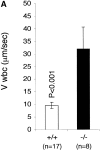The use of lymphocyte function-associated antigen (LFA)-1-deficient mice to determine the role of LFA-1, Mac-1, and alpha4 integrin in the inflammatory response of neutrophils
- PMID: 11457896
- PMCID: PMC2193453
- DOI: 10.1084/jem.194.2.219
The use of lymphocyte function-associated antigen (LFA)-1-deficient mice to determine the role of LFA-1, Mac-1, and alpha4 integrin in the inflammatory response of neutrophils
Abstract
After injury or infection, neutrophils rapidly migrate from the circulation into tissues by means of an orderly progression of adhesion receptor engagements. Neutrophils have been previously considered to use selectins exclusively to roll on vessels before an adhesion step mediated by the beta2 integrins, lymphocyte function-associated antigen (LFA)-1, and Mac-1. Here we use LFA-1(-/-) mice, function blocking monoclonal antibodies, and intravital microscopy to investigate the roles of LFA-1, Mac-1, and alpha4 integrins in neutrophil recruitment in vivo. For the first time, we show that LFA-1 makes a contribution to neutrophil rolling by stabilizing the transient attachment or tethering phase of rolling. In contrast, Mac-1 does not appear to be important for either rolling or firm adhesion, but instead contributes to emigration from the vessel. Blocking Mac-1 in the presence of LFA-1 significantly reduces emigration, suggesting cooperation between these two integrins. Low levels of alpha4beta1 integrin can be detected on neutrophils from LFA-1(+/+) and (-/-) mice. These cells make use of alpha4beta1 during the rolling phase, particularly in the absence of LFA-1. Thus LFA-1 and alpha4beta1, together with the selectins, are involved in the rolling phase of neutrophil recruitment, and, in turn, affect the later stages of the transmigration event.
Figures









Similar articles
-
Intraluminal crawling of neutrophils to emigration sites: a molecularly distinct process from adhesion in the recruitment cascade.J Exp Med. 2006 Nov 27;203(12):2569-75. doi: 10.1084/jem.20060925. Epub 2006 Nov 20. J Exp Med. 2006. PMID: 17116736 Free PMC article.
-
Relative contribution of LFA-1 and Mac-1 to neutrophil adhesion and migration.J Immunol. 1999 Nov 1;163(9):5029-38. J Immunol. 1999. PMID: 10528208
-
Rat blood neutrophils express very late antigen 4 and it mediates migration to arthritic joint and dermal inflammation.J Exp Med. 1996 May 1;183(5):2175-84. doi: 10.1084/jem.183.5.2175. J Exp Med. 1996. PMID: 8642327 Free PMC article.
-
Possible steps involved in the transition to stationary adhesion of rolling neutrophils: a brief review.Microcirculation. 2000 Dec;7(6 Pt 1):385-94. Microcirculation. 2000. PMID: 11142335 Review.
-
Shape and shift changes related to the function of leukocyte integrins LFA-1 and Mac-1.J Leukoc Biol. 2001 Jun;69(6):893-8. J Leukoc Biol. 2001. PMID: 11404373 Review.
Cited by
-
The Role of Leukocytes in Diabetic Cardiomyopathy.Front Physiol. 2018 Nov 1;9:1547. doi: 10.3389/fphys.2018.01547. eCollection 2018. Front Physiol. 2018. PMID: 30443223 Free PMC article. Review.
-
AL-57, a ligand-mimetic antibody to integrin LFA-1, reveals chemokine-induced affinity up-regulation in lymphocytes.Proc Natl Acad Sci U S A. 2006 Sep 19;103(38):13991-6. doi: 10.1073/pnas.0605716103. Epub 2006 Sep 8. Proc Natl Acad Sci U S A. 2006. PMID: 16963559 Free PMC article.
-
Avidity modulation activates adhesion under flow and requires cooperativity among adhesion receptors.Biophys J. 2003 Dec;85(6):4122-33. doi: 10.1016/S0006-3495(03)74824-3. Biophys J. 2003. PMID: 14645099 Free PMC article.
-
A novel form of integrin dysfunction involving beta1, beta2, and beta3 integrins.J Clin Invest. 2003 Jan;111(1):51-60. doi: 10.1172/JCI14076. J Clin Invest. 2003. PMID: 12511588 Free PMC article.
-
Effect of lower extremity bypass surgery on inflammatory reaction and endothelial dysfunction in type 2 diabetic patients.Mediators Inflamm. 2009;2009:417301. doi: 10.1155/2009/417301. Epub 2009 Apr 5. Mediators Inflamm. 2009. PMID: 19360107 Free PMC article.
References
-
- Albelda S.M., Smith C.W., Ward P.A. Adhesion molecules and inflammatory injury. FASEB J. 1994;8:504–512. - PubMed
-
- Johnston B., Kubes P. The α4-integrinan alternative pathway for neutrophil recruitment? Immunol. Today. 1999;20:545–550. - PubMed
-
- Ibbotson G.C., Doig C., Kaur J., Gill V., Ostrovsky L., Fairhead T., Kubes P. Functional α4-integrina newly identified pathway of neutrophil recruitment in critically ill septic patients. Nat. Med. 2001;7:465–470. - PubMed
-
- Rutter J., James T.J., Howat D., Shock A., Andrew D., De Baetselier P., Blackford J., Wilkinson J.M., Higgs G., Hughes B. The in vivo and in vitro effects of antibodies against rabbit β2-integrins. J. Immunol. 1994;153:3724–3733. - PubMed
MeSH terms
Substances
LinkOut - more resources
Full Text Sources
Other Literature Sources
Molecular Biology Databases
Research Materials

